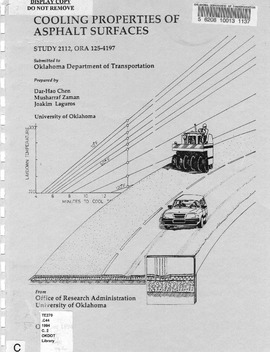| dc.creator | Chen, Dar-Hao, Zaman, Musharraf, Laguros, Joakim | |
| dc.date.accessioned | 2018-09-06T21:52:11Z | |
| dc.date.available | 2018-09-06T21:52:11Z | |
| dc.date.issued | 1994-10 | |
| dc.identifier.govdoc | FHWA-OK-94-05 | |
| dc.identifier.other | Oklahoma Department of Transportation State Planning and Research item number 2112 | |
| dc.identifier.uri | https://hdl.handle.net/11244/301638 | |
| dc.description.abstract | Cooling properties of hot mix asphalt (HMA) are important to transportation agencies and contractors in a surfacing or resurfacing operation. The cooling rate of an HMA overlay dictates how soon a roadway can be opened to traffic without having any potentially serious consequences on the pavement performance. The ease or difficulty of compacting HMA paving mixt?res by rolling is influenced by the viscosity-temperature characteristics of the asphalt cement and the temperature of the mix during compaction. Thus, knowing the cooling rate of HMA provides the contractor information such as the extent of time within which breakdown rolling must be completed to ensure quality of the pavement and also when a roadway can be opened to traffic following a surfacing/resurfacing job without any detrimental consequences. A telephone interview was conducted with selected DOTs. From the interviews, it became evident that although several DOTs do not specify a certain temperature range, they do suggest, based on their experiences, that it is preferable to open a roadway to traffic when the HMA temperature is below l40"F. This temperature is close to the 150"F reported in the Synthesis of Highway Practice by the National Cooperative Highway Research Program (NCHRP). HMA thickness and wind velocity have been rated by the DOTs as the most significant factors that influence the cooling rate of HMA. A finite difference computer code provided in the reference as well as a general purpose finite element program ABAQUS were used to compute the time needed by a HMA layer to cool to 150"'F. In this work, the time to cool to various given average mat temperatures was computed for various laydown (200-300ÁF) and base temperatures (50-120'F). Some field data was collected from a site on 1~35 near its intersection with State Highway 51. The field data compares favorably with that obtained from the numerical model predictions for similar conditions. Therefore, the results reported here can be used, with proper engineering judgement, to determine the time required to open the road to traffic. | |
| dc.format.extent | 61 pages | |
| dc.format.extent | 31,565,439 bytes | |
| dc.format.medium | application.pdf | |
| dc.language | en_US | |
| dc.relation.ispartofseries | No | |
| dc.relation.requires | Adobe Acrobat Reader | |
| dc.title | Cooling properties of asphalt surfaces (FHWA-OK-94-05) 2112 | |
| dc.type | Technical Report | |
| dc.description.peerreview | No | |
| dc.type.material | text | |
| dc.subject.keywords | Cooling | |
| dc.subject.keywords | Hot mix asphalt | |
| dc.subject.keywords | Temperature | |
| dc.subject.keywords | Compaction | |
| dc.subject.keywords | Heat transfer | |
| dc.contributor.sponsor | Oklahoma Department of Transportation. Materials and Research Division. Office of Research & Implementation | |
